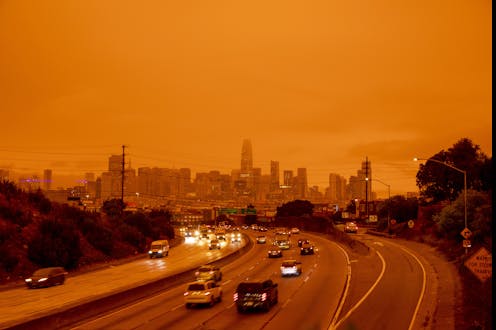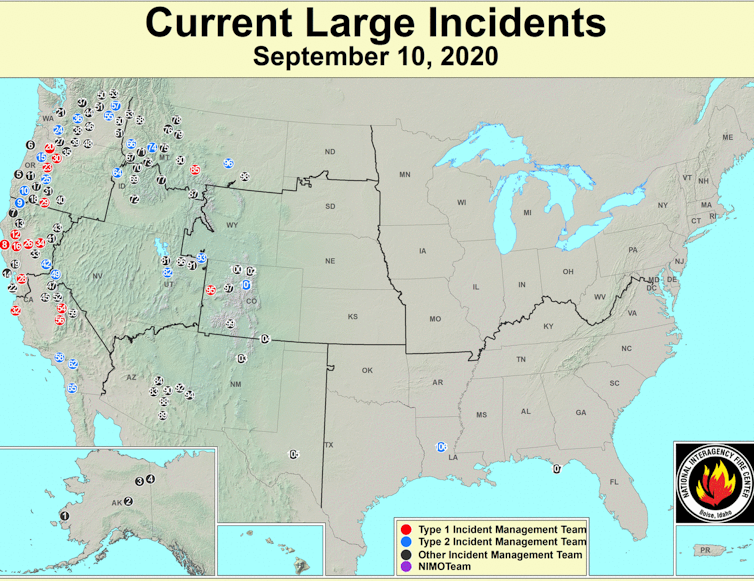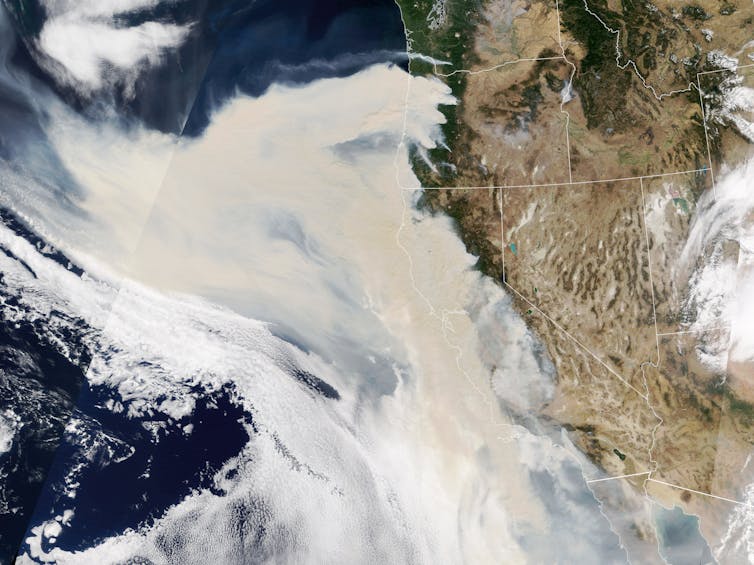Coping with Western wildfires: 5 essential reads
- Written by Jennifer Weeks, Environment + Energy Editor, The Conversation
 Wildfire smoke creates an orange glow over San Francisco, Sept. 9, 2020.Burak Arik/Anadolu Agency via Getty Images
Wildfire smoke creates an orange glow over San Francisco, Sept. 9, 2020.Burak Arik/Anadolu Agency via Getty ImagesIntense wildfires are raging in California, Oregon and Washington state, spurring mass evacuations and leaving charred towns in their wake. A regional heat wave is keeping temperatures high and humidity low, creating difficult conditions for firefighters. These five articles from The Conversation’s archive explain what’s driving Western fires and how they’re affecting residents.
1. Welcome to the Pyrocene Age
Many factors have combined to create conditions for today’s epic wildfires, including climate change, land use patterns and decades of fire suppression.
Arizona State University emeritus professor Stephen Pyne, a historian of fire, argues that Earth may be “entering a fire age comparable to the ice ages of the Pleistocene, complete with the pyric equivalent of ice sheets, pluvial lakes, periglacial outwash plains, mass extinctions and sea level changes. It’s an epoch in which fire is both prime mover and principal expression.”
This transition reflects how humans interact with the land and how they use fire, Pyne writes. Humans believed that they could contain fire on the land, as they did in factories. Meanwhile, they burned more fossil fuels, adding to combustion sources. Today, Pyne writes, “The climate is unhinged. When flame returns, as it must, it comes as wildfire.”
 More than 100 large fires were burning in 12 Western states on Sept. 10, 2020.National Interagency Fire Center
More than 100 large fires were burning in 12 Western states on Sept. 10, 2020.National Interagency Fire Center2. Climate change’s fingerprint
While climate change isn’t the only driver of Western fires, Kevin Trenberth, a senior scientist at the National Center for Atmospheric Research, sees its influence clearly. Typically, lightning, power lines or poorly doused campfires ignite these conflagrations – but climate change is making the U.S. west hotter and dryer, and thus more prone to burn.
Water “acts as the air conditioner of the planet,” Trenberth explains. “In the absence of water, the excess heat effects accumulate on land both by drying everything out and wilting plants, and by raising temperatures. In turn, this leads to heat waves and increased risk of wildfire.”
Because scientists can estimate how much extra heat climate change is adding to the atmosphere, its role in creating conditions for wildfires is clear, Trenberth argues. Researchers who study climate and fire have observed these trends playing out in the West, with longer fire seasons and more destructive fires since the 1980s.
3. Treating wildfires like earthquakes
Californians have lived for decades with the risk of earthquakes. Now, in the view of University of California Santa Barbara scholars Max Moritz, Naomi Tague and Sarah Anderson, they need to think about wildfire risk in the same way.
This means taking long-term steps, such as limiting development in the wildland-urban interface, where homes and businesses adjoin fire-prone undeveloped areas; retrofiting homes to make them more fire-resistant; and improving evacuation planning and warming systems.
“Following the roadmap for earthquakes, from seismic planning to earthquake retrofitting to education campaigns, the state can move the response to wildfire from reactive fighting to comprehensive preparedness,” the authors assert.
Wildfire damage in a residential neighborhood in Talent, Oregon, Sept. 9, 2020.4. The threat of smoke
As wildfire smoke turns Western skies orange and red, millions of people face serious health risks from inhaling it, even many who are far from active fires. Wood smoke is a complex mixture of gases and large and small particles that can cause eye and throat irritation and lung inflammation. It also can worsen asthma, cardiovascular problems – and possibly even the impacts of COVID-19, warns Luke Montrose, assistant professor of community and environmental health at Boise State University.
If you’re downwind from a wildfire, Montrose offers this advice: Pay attention to local air alerts; avoid being outdoors or engaging in strenuous exercise; use a window air conditioner and a portable air purifier to create a clean, cool space; and skip activities that can add to indoor air pollution, such as burning candles or lighting gas stoves.
 Thick smoke streams from a line of intense fires in California and Oregon, Sept. 9, 2020.NASA Earth Observatory
Thick smoke streams from a line of intense fires in California and Oregon, Sept. 9, 2020.NASA Earth Observatory5. Pricing wildfire risks
Property and casualty insurance often covers damage from disasters such as wildfires. But in many parts of California, observes Stanford University’s Gireesh Shrimali, that coverage has become unaffordable for thousands of Californians.
As insurers drop policyholders in fire-prone areas, the main alternative is a state-backed insurance pool that provides basic coverage at a high price as a last resort. To address this squeeze, Shrimali recommends separating wildfire coverage from general property insurance and requiring all California homeowners to purchase it. He also calls for risk-based pricing, so that owners pay more if they choose to build or buy in fire-prone areas.
“Insurance is not a substitute for fire prevention policies or investments in wildfire response, but it is one necessary tool for managing the state’s serious wildfire risks,” Shrimali writes.
Authors: Jennifer Weeks, Environment + Energy Editor, The Conversation
Read more https://theconversation.com/coping-with-western-wildfires-5-essential-reads-145965

